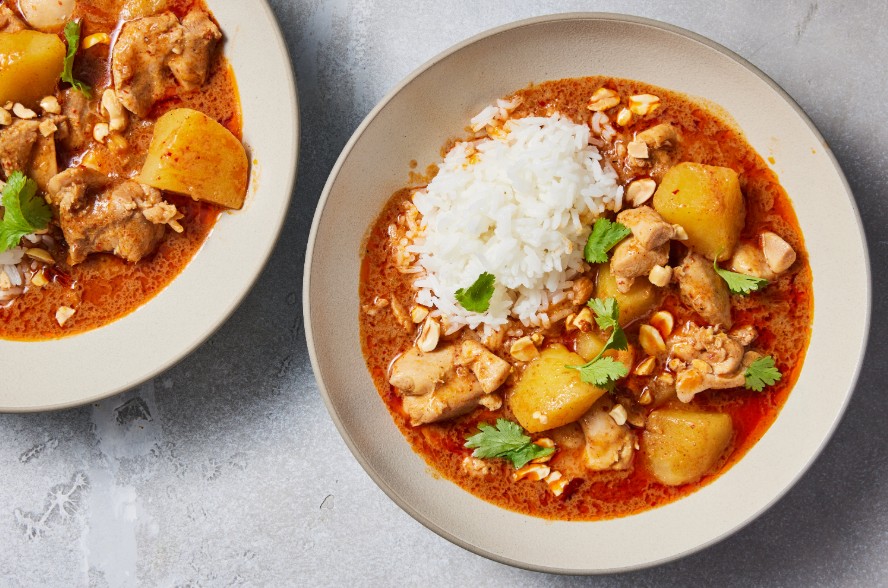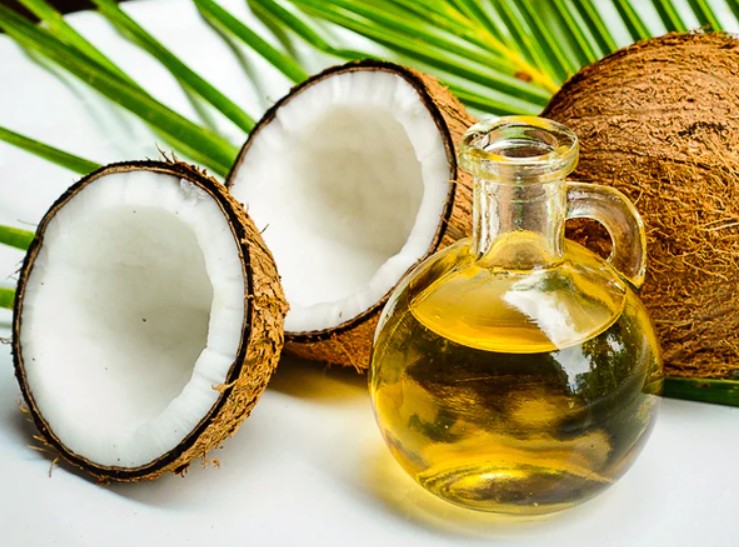
I still remember the first time I tasted Massaman curry. It was on a hot afternoon in Chiang Mai, tucked away in a small family-run restaurant that smelled like roasted peanuts and coconut milk. I had no idea that bowl of golden-brown curry would change how I viewed Thai food forever.
Massaman isn’t just another Thai dish — it’s a love letter to flavor. It’s sweet, savory, nutty, and slightly tangy all at once. The kind of meal that wraps around you like a warm blanket on a rainy day.
Over the years, I’ve experimented (and yes, failed a few times) to recreate that same magic at home. The key, I learned, isn’t just about following a recipe — it’s about understanding the soul of Massaman curry.
What Makes Massaman Curry So Special
Massaman curry, or “Matsaman” as locals might pronounce it, isn’t your typical spicy Thai curry. Its roots trace back to southern Thailand, influenced by Persian and Indian traders centuries ago. That’s why it feels different — deeper in spices like cardamom, cinnamon, and cumin — yet balanced beautifully with Thai ingredients like lemongrass, galangal, and fish sauce.
The result? A curry that’s both rich and gentle. Perfect for those who find green curry too spicy but still want something exotic and comforting. The fusion of cultures in one pot is what makes it truly fascinating.
And honestly, that’s what I love about Thai cooking: it’s global but grounded, spicy but soulful.
Gathering the Ingredients (and Why Each One Matters)
When I first tried making Massaman curry at home, I made the mistake of substituting too many ingredients. Big mistake. Authenticity matters here because every spice and sauce plays a role in creating that layered depth.
Here’s what you’ll need — and why.
For the Curry Paste (if making from scratch)
You can buy store-bought paste (Mae Ploy and Maesri are solid brands), but making it yourself is oddly satisfying.
- 4 dried red chilies (soaked and deseeded) – for mild heat and color.
- 1 shallot – gives sweetness and body.
- 3 cloves garlic – the backbone of Thai curry flavor.
- 1 stalk lemongrass (white part) – brings citrusy brightness.
- 1 tsp galangal (or ginger if you can’t find it) – adds warmth.
- 1 tsp coriander seeds – earthy and aromatic.
- ½ tsp cumin seeds – Indian influence right here.
- 1 small cinnamon stick – unexpected, but crucial.
- 2 cloves & 2 cardamom pods – gives Massaman that signature aroma.
- 1 tbsp roasted peanuts – this is where that nutty undertone begins.
- 1 tbsp shrimp paste (optional) – for a deeper umami flavor.
Pound everything in a mortar and pestle until smooth. It’s hard work, I won’t lie. But as you grind the spices together, that scent — oh man — it’s like standing in a Thai kitchen.
For the Curry Itself
- 500g beef (or chicken or tofu for vegetarian) – beef brisket or chuck gives the best tenderness.
- 2 cups coconut milk – the creamy heart of the curry.
- 2 potatoes, cubed – they absorb the flavor beautifully.
- 1 onion, sliced – adds sweetness and depth.
- 2 tbsp tamarind juice – for that gentle tang.
- 2 tbsp palm sugar (or brown sugar) – balances the heat and spice.
- 2 tbsp fish sauce (or soy sauce for vegetarians) – adds saltiness and umami.
- ½ cup roasted peanuts – crunch and aroma.
- 1 stick cinnamon – subtle warmth that ties everything together.
Cooking Massaman Curry Like a Local (and Avoiding My Early Mistakes)
Alright, let’s talk technique. I’ve messed this up before — adding ingredients in the wrong order, boiling coconut milk too hard, or not letting the meat simmer long enough.
Thai cooking is patient cooking. It’s more like jazz than a strict recipe. You learn to listen to the bubbling pot, smell the curry, and taste as you go.
Here’s how I finally nailed it.
- Fry the curry paste first.
Heat a bit of coconut cream (the thick part that sits on top of the can) in a wok or pot until it starts to separate slightly. Then, stir in your curry paste and fry it slowly. You’ll know it’s ready when the oil starts to release from the paste — that’s where the magic begins.
This step deepens the flavor and gives your curry that restaurant-level aroma. - Add the meat and coat it well.
Toss in your beef or chicken and make sure every piece is covered in the paste. This helps lock in flavor early. - Add coconut milk, cinnamon, and peanuts.
Let it all simmer gently. Don’t rush this. The slow cooking makes the meat tender and allows the spices to mingle like old friends.
(One time, I got impatient and turned the heat up. Big mistake. The coconut milk curdled, and the curry split. It still tasted okay, but it wasn’t pretty.) - Add potatoes and onions.
These soak up the curry like sponges, making every bite flavorful. - Balance with tamarind, fish sauce, and sugar.
This is where Thai cooking philosophy shines — sweet, sour, salty, spicy — all in perfect harmony. Adjust slowly, tasting along the way.
After about an hour of simmering, your kitchen should smell like heaven. That’s when you know it’s ready.
Serving Suggestions: The Right Way to Enjoy It
Massaman curry pairs beautifully with steamed jasmine rice or roti bread. The soft rice helps soak up all that rich sauce, while roti adds a buttery contrast.
I sometimes top mine with fresh cilantro or a sprinkle of crushed peanuts. My Thai friend once told me, “Curry is not about the garnish — it’s about the moment.” And she was right.
Serve it hot, ideally shared with family or friends. Massaman isn’t a solo meal; it’s made for company, laughter, and second servings.
My Tips for Making It Unforgettable
Over the years, I’ve discovered a few tricks that consistently make my Massaman curry shine:
- Use fresh spices. Old spices lose their power. Toast them before grinding to release their oils.
- Don’t skimp on the coconut milk. The thicker, the better. Avoid “light” versions — they’re too watery.
- Low and slow cooking. Especially for beef. The longer it simmers, the more tender and flavorful it becomes.
- Adjust balance at the end. A little tamarind or sugar tweak can make all the difference.
- Let it rest. Like a good stew, Massaman tastes even better the next day as the flavors meld together.
A Quick Vegetarian or Vegan Twist
Not a meat eater? No worries. Massaman curry adapts beautifully.
Swap beef for tofu, chickpeas, or jackfruit. Use vegetable stock instead of meat broth and soy sauce instead of fish sauce.
I’ve made vegan Massaman a few times for friends, and honestly, it’s still rich and satisfying. The peanuts and coconut milk do all the heavy lifting for creaminess.
The Cultural Story Behind the Curry
Here’s something fascinating: Massaman curry was once a dish served to Thai royalty. It came from Persian merchants who brought their spices to Ayutthaya (the old capital of Thailand) centuries ago.
That’s why you find spices like cardamom and cinnamon — they’re not native to typical Thai food but came from those early global connections.
The word “Massaman” likely comes from “Mussulman,” meaning Muslim, which explains the use of halal meats in some traditional versions.
So, every time you eat this curry, you’re tasting history — a blend of Thai and Persian cultures simmered together over centuries. Pretty amazing, right?
Common Mistakes (and How to Avoid Them)
I’ll be honest — I made every mistake possible when I started.
- Boiling coconut milk too hard.
It curdles and separates. Always simmer gently. - Not frying the paste long enough.
Undercooked paste makes the curry taste flat. Wait for that fragrant oil to release. - Adding all ingredients at once.
It’s tempting but wrong. Layer them — protein first, then coconut milk, then veggies. - Ignoring the balance.
If it tastes “off,” tweak the sugar, tamarind, or fish sauce. Massaman should never be too sweet or salty. - Using lean cuts of meat.
Don’t. Fatty cuts melt beautifully into the curry. That’s flavor you can’t fake.
Health Benefits (Because Food Should Be Delicious and Good for You)
Despite its richness, Massaman curry isn’t all indulgence. Coconut milk is packed with good fats, and the spices — turmeric, cinnamon, cardamom — all have anti-inflammatory properties.
Add in some veggies, and you’ve got a meal that’s hearty yet nourishing.
Of course, portion control helps. (I say that, but let’s be real — resisting a second serving is tough.)
A Personal Reflection: Why Massaman Curry Feels Like Home
There’s something deeply comforting about this dish. Maybe it’s the slow cooking, or the aroma of cinnamon and peanuts wafting through the air. Maybe it’s how it brings people together.
Whenever I cook it now, I think back to that tiny restaurant in Chiang Mai — the owner smiling as she handed me that steaming bowl. I remember thinking, How can something taste both familiar and foreign at the same time?
That’s the beauty of Massaman curry. It’s a crossroads dish — a reminder that the best flavors often come from cultural blending and patience.
Cooking it isn’t just about feeding yourself. It’s about honoring a story that started centuries ago and continues every time someone takes a bite.
Final Thoughts: Bring Thailand to Your Kitchen
If you’ve never tried making Massaman curry before, don’t be intimidated. Start simple, taste as you go, and don’t stress about perfection.
The joy is in the process — the pounding of the curry paste, the simmering pot, the little dance your kitchen does with every aroma.
Whether you’re cooking it for family, a special date, or just yourself after a long day, Massaman curry never disappoints. It’s rich, complex, and deeply comforting — just like the best parts of life.
SEO-Optimized FAQ
- What meat is best for Massaman curry?
Beef brisket or chuck is traditional because it becomes tender after slow simmering. Chicken thighs also work great if you prefer poultry. - Can I make Massaman curry vegetarian or vegan?
Yes! Swap meat for tofu, jackfruit, or chickpeas, and use soy sauce instead of fish sauce. The flavor stays authentic and rich. - How long does Massaman curry last?
Stored in the fridge, it lasts up to 3–4 days. The flavor deepens over time, so the next day’s leftovers are even better. - What’s the difference between Massaman and Panang curry?
Massaman is milder, with more Indian-style spices like cinnamon and cardamom. Panang is thicker, spicier, and uses more chili and kaffir lime. - Can I freeze Massaman curry?
Absolutely. Freeze in airtight containers for up to 2 months. Reheat gently to maintain the coconut milk texture.








